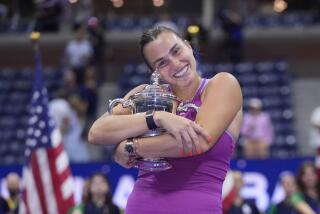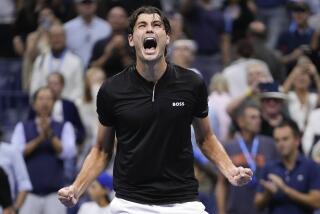Safin Sweep Has Shades of a Re-Pete
NEW YORK — His opponent looked unsure of himself, perhaps intimidated even.
His crackling serve, whistling off his racket at speeds reaching 136 mph, unnerved his helpless foe, who never even got to break point until the final game of the match.
At every critical moment, he had the right answer, whether it be a sizzling passing shot down the line, an overhead smash that was impossible to reach or a well-timed lob that found the corner.
Marat Safin of Russia turned the tables Sunday, ripping through Pete Sampras, 6-4, 6-3, 6-3, in only 98 minutes to win the U.S. Open championship before 23,115 here in Arthur Ashe Stadium.
In a stunning performance that may have ushered in a new era in men’s tennis, the 20-year-old Safin neither backed down against the 29-year-old Sampras, who had lost only twice in 15 previous Grand Slam finals, nor succumbed to the pressure of playing in his first Grand Slam final.
“He reminded me of when I was 19 and came here and won for the first time,” said Sampras, who 10 years ago this week defeated Andre Agassi, 6-4, 6-3, 6-2, to begin his record run of 13 Grand Slam championships. “I steamrolled over Andre and I was steamrolled today by him. . . .
“He passed me and returned my serve as well as anyone I’ve ever played, so all credit to him.”
Safin, the first Russian to win the U.S. Open, kept the pressure on right to the end, ripping a backhand passing shot past the charging Sampras on match point.
At last showing that he realized the enormousness of the occasion, Safin raised his arms in celebration and dropped to his knees to kiss the court, then climbed into the stands to hug his supporters.
“Probably I was less nervous than him because for him it’s very important to win here, in New York, with the crowd,” Safin said of Sampras, who was seeking his fifth U.S. Open title, which would have tied him with Jimmy Connors for most in the open era. “I mean, 20,000 people coming to see you.
“I’m just the guy from Russia who had not a lot of spectators here, so I had nothing to lose, completely nothing. So I just played my game. I was relaxed.”
Even with the crowd trying to egg him on by chanting, “Let’s go, Pete, let’s go, Pete,” Sampras could not summon a consistent counterattack against Safin, a 6-foot-4 baseliner with a powerful serve that, on this day, was superior to his rival’s.
From down, 3-2, in the second set to up, 3-0, in the third, Safin won seven consecutive games.
He had 12 aces, 37 winners and only 12 unforced errors.
“It hasn’t happened very often that I’ve been on the receiving end of a barrage of shots like that,” Sampras said. “I’m usually the one doing that. It’s a bit of a humbling feeling to have someone play that well against you for that long. . . .
“It hasn’t happened to me that often that I’ve kind of gotten the car waxed like that.”
The temperamental Safin, as well known before Sunday for smashing rackets as for winning matches, faltered only slightly in the last game, when nerves finally got to him and Sampras reached break point for the first time.
“I knew if I would miss this, I can lose,” Safin said. “That’s why I make double fault. I didn’t know what to do. I was under pressure. I couldn’t play. I couldn’t serve.
“I don’t know what going to happen if I lose this game. I don’t want to think about this. I was nervous. I cannot explain what I felt. It’s now or never.”
When he closed out the match with one final winner, Safin completed a dramatic rise from first-round loser at the Australian Open eight months ago, when his effort against Grant Stafford of South Africa was considered so suspect that he was docked $2,000 for tanking, to U.S. Open champion.
Safin, who moved from Moscow when he was 13 to train year-round in Valencia, Spain, said he was playing so poorly last spring that he considered quitting.
But then in May he won a tournament in Mallorca, Spain, and started to gain confidence. Last month, he beat Sampras in the quarterfinals on his way to winning a tournament in Toronto.
Still, he gave no hint of the dominance that transpired Sunday. Twice in the first week of the tournament the sixth-seeded Safin had been pushed to five sets by lesser players, Gianluca Pozzi of Italy and Sebastien Grosjean of France.
“I felt like I didn’t know how to play tennis anymore,” he said. “I was making so many mistakes.
“I found my game after match [against] Grosjean because I was scared to lose. I just understand that I can lose here very easy.”
Against Sampras’ vaunted serve, Safin never wavered.
“I never return better,” he said.
A year from now, he’ll return as the U.S. Open champion.
“I can’t explain to you right now what I feel,” he said. “I’m still a little bit in the match, in the last game. It’s very difficult feeling in the last game. I had adrenaline all over my body. I was so scared, I didn’t understand.
“I cannot think about how great it is to win a Grand Slam.”
*
REIGN OUT
Marat Safin, who had 37 winners, was so dominant he had 13-time Grand Slam winner Pete Sampras talking in humbling terms--and that may signal a new era in tennis, J.A. Adande writes. Page 15
More to Read
Go beyond the scoreboard
Get the latest on L.A.'s teams in the daily Sports Report newsletter.
You may occasionally receive promotional content from the Los Angeles Times.










